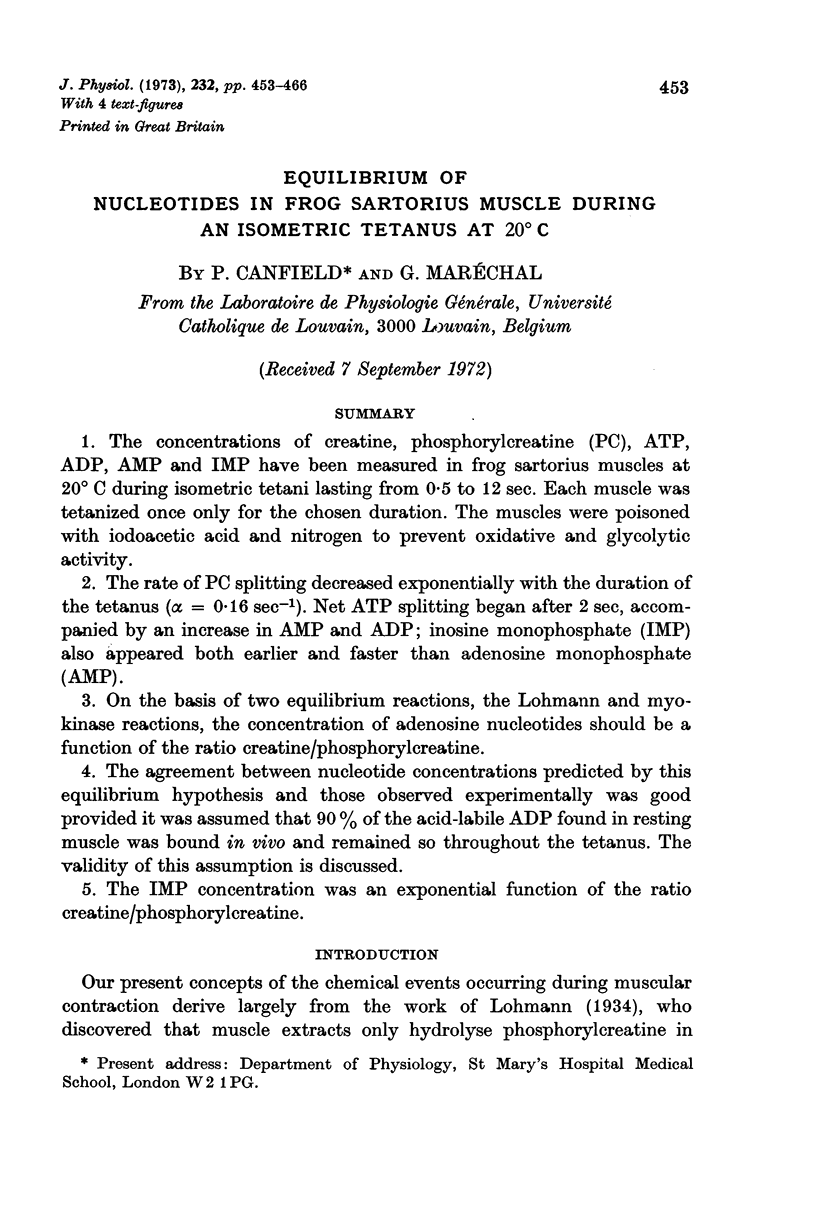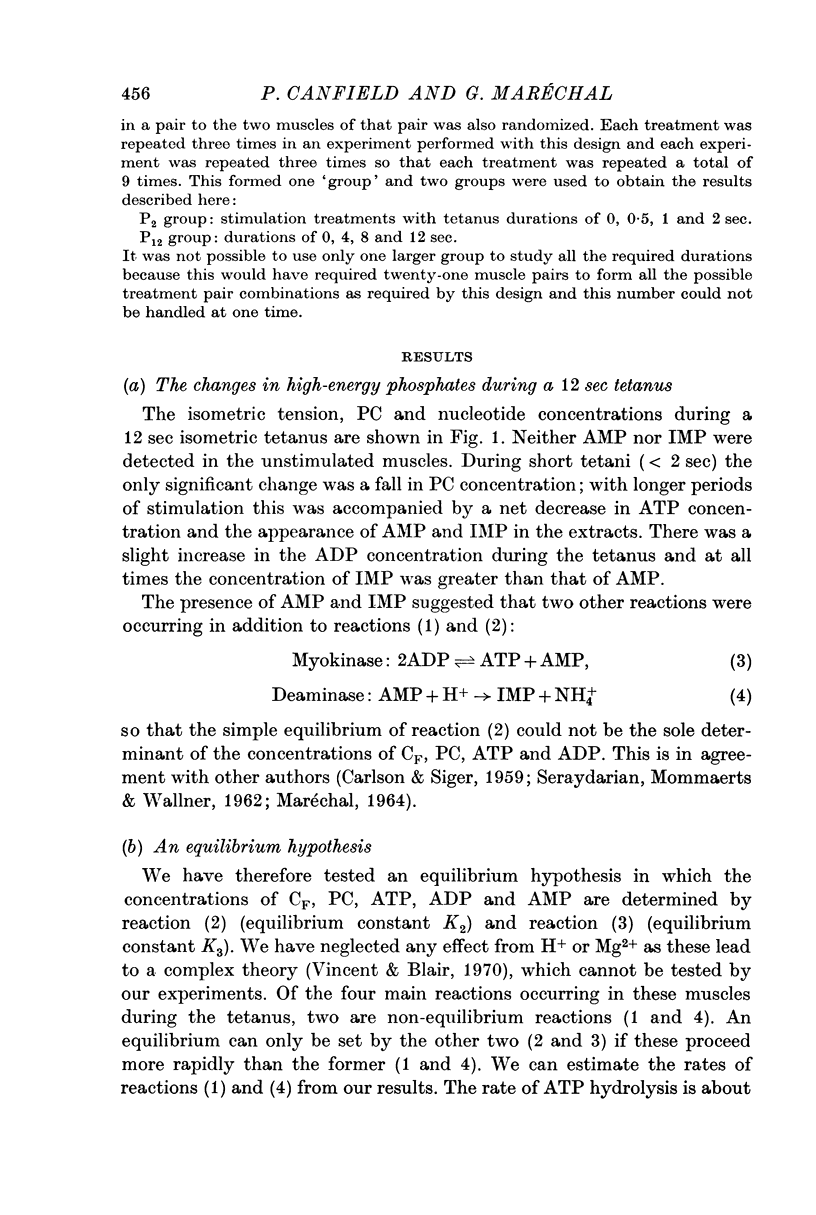Abstract
1. The concentrations of creatine, phosphorylcreatine (PC), ATP, ADP, AMP and IMP have been measured in frog sartorius muscles at 20° C during isometric tetani lasting from 0·5 to 12 sec. Each muscle was tetanized once only for the chosen duration. The muscles were poisoned with iodoacetic acid and nitrogen to prevent oxidative and glycolytic activity.
2. The rate of PC splitting decreased exponentially with the duration of the tetanus (α = 0·16 sec-1). Net ATP splitting began after 2 sec, accompanied by an increase in AMP and ADP; inosine monophosphate (IMP) also appeared both earlier and faster than adenosine monophosphate (AMP).
3. On the basis of two equilibrium reactions, the Lohmann and myokinase reactions, the concentration of adenosine nucleotides should be a function of the ratio creatine/phosphorylcreatine.
4. The agreement between nucleotide concentrations predicted by this equilibrium hypothesis and those observed experimentally was good provided it was assumed that 90% of the acid-labile ADP found in resting muscle was bound in vivo and remained so throughout the tetanus. The validity of this assumption is discussed.
5. The IMP concentration was an exponential function of the ratio creatine/phosphorylcreatine.
Full text
PDF













Selected References
These references are in PubMed. This may not be the complete list of references from this article.
- BOWEN W. J., KERWIN T. D. The purification of myokinase with ion exchange resin. Arch Biochem Biophys. 1955 Aug;57(2):522–524. doi: 10.1016/0003-9861(55)90316-7. [DOI] [PubMed] [Google Scholar]
- CAIN D. F., DAVIES R. E. Breakdown of adenosine triphosphate during a single contraction of working muscle. Biochem Biophys Res Commun. 1962 Aug 7;8:361–366. doi: 10.1016/0006-291x(62)90008-6. [DOI] [PubMed] [Google Scholar]
- CAIN D. F., INFANTE A. A., DAVIES R. E. Chemistry of muscle contraction. Adenosine triphosphate and phosphorylcreatine as energy supplies for single contractions of working muscle. Nature. 1962 Oct 20;196:214–217. doi: 10.1038/196214a0. [DOI] [PubMed] [Google Scholar]
- CARLSON F. D., SIGER A. The creatine phosphoryltransfer reaction in iodoacetate-poisoned muscle. J Gen Physiol. 1959 Nov;43:301–313. doi: 10.1085/jgp.43.2.301. [DOI] [PMC free article] [PubMed] [Google Scholar]
- CHANCE B., CONNELLY C. M. A method for the estimation of the increase in concentration of adenosine diphosphate in muscle sarcosomes following a contraction. Nature. 1957 Jun 15;179(4572):1235–1237. doi: 10.1038/1791235a0. [DOI] [PubMed] [Google Scholar]
- Canfield P., Lebacq J., MARECHAL G. Energy balance in frog sartorius muscle during an isometric tetanus at 20 degrees C. J Physiol. 1973 Aug;232(3):467–483. doi: 10.1113/jphysiol.1973.sp010281. [DOI] [PMC free article] [PubMed] [Google Scholar]
- Cerretelli P., Di Prampero P. E., Ambrosoli G. High-energy phosphate resynthesis from anaerobic glycolysis in frog gastrocnemius muscle. Am J Physiol. 1972 Apr;222(4):1021–1026. doi: 10.1152/ajplegacy.1972.222.4.1021. [DOI] [PubMed] [Google Scholar]
- EGGLESTON L. V., HEMS R. Separation of adenosine phosphates by paper chromotography and the equilibrium constant of the myokinase system. Biochem J. 1952 Sep;52(1):156–160. doi: 10.1042/bj0520156. [DOI] [PMC free article] [PubMed] [Google Scholar]
- Ennor A. H., Stocken L. A. The estimation of creatine. Biochem J. 1948;42(4):557–563. doi: 10.1042/bj0420557. [DOI] [PMC free article] [PubMed] [Google Scholar]
- HILL A. V. The thermodynamics of elasticity in resting striated muscle. Proc R Soc Lond B Biol Sci. 1952 Jul 10;139(897):464–passim. doi: 10.1098/rspb.1952.0024. [DOI] [PubMed] [Google Scholar]
- HOHORST H. J., REIM M., BARTELS H. Studies on the creatine kinase equilibrium in muscle and the significance of ATP and ADP levels. Biochem Biophys Res Commun. 1962 Apr 3;7:142–146. doi: 10.1016/0006-291x(62)90163-8. [DOI] [PubMed] [Google Scholar]
- KUBY S. A., NODA L., LARDY H. A. Adenosinetriphosphate-creatine transphosphorylase. III. Kinetic studies. J Biol Chem. 1954 Sep;210(1):65–82. [PubMed] [Google Scholar]
- Kirsten E., Kirsten R. High energy phosphates in a red and a white muscle of the rat. Pflugers Arch. 1969;311(3):209–225. doi: 10.1007/BF00590526. [DOI] [PubMed] [Google Scholar]
- MARECHAL G., MOMMAERTS W. F. The metabolism of phosphocreatine during an isometric tetanus in the frog sartorius muscle. Biochim Biophys Acta. 1963 Feb 19;70:53–67. doi: 10.1016/0006-3002(63)90718-2. [DOI] [PubMed] [Google Scholar]
- NODA L., KUBY S. A. Adenosine triphosphate-adenosine monophosphate transphosphorylase (myokinase). I. Isolation of the crystalline enzyme from rabbit skeletal muscle. J Biol Chem. 1957 May;226(1):541–549. [PubMed] [Google Scholar]
- Ronca-Testoni S., Raggi A., Ronca G. Muscle AMP aminohydrolase. 3. A comparative study on the regulatory properties of skeletal muscle enzyme from various species. Biochim Biophys Acta. 1970 Jan 14;198(1):101–112. doi: 10.1016/0005-2744(70)90038-0. [DOI] [PubMed] [Google Scholar]
- SERAYDARIAN K., MOMMAERTS W. F., WALLNER A. The amount and compartmentalization of adenosine diphosphate in muscle. Biochim Biophys Acta. 1962 Dec 17;65:443–460. doi: 10.1016/0006-3002(62)90447-x. [DOI] [PubMed] [Google Scholar]
- Vincent A., Blair J. M. The coupling of the adenylate kinase and creatine kinase equilibria. Calculation of substrate and feedback signal levels in muscle. FEBS Lett. 1970 Apr 16;7(3):239–244. doi: 10.1016/0014-5793(70)80170-3. [DOI] [PubMed] [Google Scholar]
- Wilkie D. R. Heat work and phosphorylcreatine break-down in muscle. J Physiol. 1968 Mar;195(1):157–183. doi: 10.1113/jphysiol.1968.sp008453. [DOI] [PMC free article] [PubMed] [Google Scholar]


